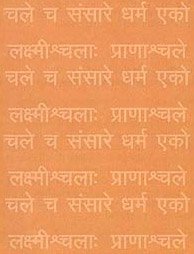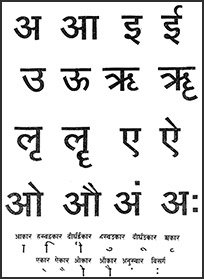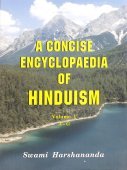Vyahriti, Vyāhṛti: 18 definitions
Introduction:
Vyahriti means something in Hinduism, Sanskrit, Marathi. If you want to know the exact meaning, history, etymology or English translation of this term then check out the descriptions on this page. Add your comment or reference to a book if you want to contribute to this summary article.
The Sanskrit term Vyāhṛti can be transliterated into English as Vyahrti or Vyahriti, using the IAST transliteration scheme (?).
In Hinduism
Vedanta (school of philosophy)
Source: WikiSource: Taittiriya UpanishadBhu, Bhuvas, Suvas, these are the three sacred interjections (vyahriti). Mahakamasya taught a fourth, viz. Mahas, which is Brahman, which is the Self. The others (devatas) are its members.
- Bhu is this world,
- Bhuvas is the sky,
- Suvas is the other world.
Mahas is the sun. All the worlds are increased by the sun.
- Bhu is Agni (fire),
- Bhuvas is Vayu (air),
- Suvas is Aditya (sun).
Mahas is the moon. All the heavenly lights are increased by the moon.
- Bhu is the Rik-verses,
- Bhuvas is the Saman-verses,
- Suvas is the Yagus-verses.
Mahas is Brahman. All theVedas are increased by the Brahman.
- Bhu is Prana (up-breathing),
- Bhuvas is Apana (down-breathing),
- Suvas is Vyana (backbreathing).
Mahas is food. All breathings are increased by food.
Thus there are these four times four, the four and four sacred interjections. He who knows these, Knows the Brahman. All Devas bring offerings to him.

Vedanta (वेदान्त, vedānta) refers to a school of orthodox Hindu philosophy (astika), drawing its subject-matter from the Upanishads. There are a number of sub-schools of Vedanta, however all of them expound on the basic teaching of the ultimate reality (brahman) and liberation (moksha) of the individual soul (atman).
Shaktism (Shakta philosophy)
Source: Wisdom Library: Śrīmad Devī BhāgavatamVyāhṛti (व्याहृति, “utterance, statement, speech”):—One of the names attributed to Devī, as chanted by the Vedas in their hymns, who were at the time incarnated in their personified forms. See the Devī-bhāgavata-purāṇa chapter 5.51-68, called “the narrative of Hayagrīva”.

Shakta (शाक्त, śākta) or Shaktism (śāktism) represents a tradition of Hinduism where the Goddess (Devi) is revered and worshipped. Shakta literature includes a range of scriptures, including various Agamas and Tantras, although its roots may be traced back to the Vedas.
Purana and Itihasa (epic history)
Source: archive.org: Shiva Purana - English TranslationVyāhṛtī (व्याहृती) are the mystical utterances, seven in number, viz. “bhūḥ, bhuvaḥ, svaḥ, mahaḥ, janaḥ, tapaḥ, satyam |”. Each of the vyāhṛtis are preceded by the [Praṇava] Om.
Source: Cologne Digital Sanskrit Dictionaries: The Purana Index
Vyāhṛti (व्याहृति).—Daughters of Savitā;1 three in number.2

The Purana (पुराण, purāṇas) refers to Sanskrit literature preserving ancient India’s vast cultural history, including historical legends, religious ceremonies, various arts and sciences. The eighteen mahapuranas total over 400,000 shlokas (metrical couplets) and date to at least several centuries BCE.
Vyakarana (Sanskrit grammar)
Source: Wikisource: A dictionary of Sanskrit grammarVyāhṛti (व्याहृति).—Or व्याहृती (vyāhṛtī) lit. the utterance of a word; the word is generally used in the sense of the specific utterance of the words भूः, भुवः (bhūḥ, bhuvaḥ) etc; cf. एताभिर्व्याहृतीभिः प्रजापतिः (etābhirvyāhṛtībhiḥ prajāpatiḥ) Tait. Sarh I. 6. 10; cf. also भुवश्च महाव्याहृतेः (bhuvaśca mahāvyāhṛteḥ) P. VIII. 2.71.

Vyakarana (व्याकरण, vyākaraṇa) refers to Sanskrit grammar and represents one of the six additional sciences (vedanga) to be studied along with the Vedas. Vyakarana concerns itself with the rules of Sanskrit grammar and linguistic analysis in order to establish the correct context of words and sentences.
General definition (in Hinduism)
Source: WikiPedia: HinduismIn the Puranas, and already in the Atharvaveda, there are fourteen worlds, seven higher ones (vyahrtis) and seven lower ones (patalas), viz.
- bhu,
- bhuvas,
- svar,
- mahas,
- janas,
- tapas, and
- satya
above and
- atala,
- vitala,
- sutala,
- rasaataala,
- talatala,
- mahaatala,
- patala and
- naraka
below.
Source: Krishna Science: Gayatri Mahima MadhuriThe vyahritis were made at the beginning of creation and represent the seven planetary systems including Bhur, Bhuvah, Svah, Mahah, Janah, Tapah, and Satyalokas. Besides denoting the seven worlds, the vyahritis denote the seven planes of consciousness. The mantras are prayers directed to the elemental forces on the seven planes. These elemental forces are manifestations of the Parabrahman itself.
The seven worlds are embodied in the trinity of bhur, bhuvah, and svah.
- Bhur or bhu represents earth or the physical plane.
- Bhuvah represents the sky or astral plane.
- Svah represents heaven or the mental plane.
- Maharloka represents a higher plane.
- Janah represents the place of birth, a still higher plane.
- Tapah represents the mansion of the Blessed, an even higher plane.
- Satyam represents the abode of truth, the highest plane.
It is sometimes said that these vyahritis (bhur, bhuvah, svah) which appear in the beginning of the Brahma-gayatri represent the sapta rsis (seven great sages) including Visvamitra, Jamadagni, Bharadvaja, Gautama, Atri, Vasistha, and Kasyapa. The seven devatas of this mantra (bhur, bhuvah, and svah) are Agni, Vayu, Aditya, Brhaspati, Varuna, Indra, and Visva Devata.
Besides referring to the upper, middle and lower planets (i.e. the complete universe or creation), bhur, bhuvah, svah signify the material body. Sripada Madhvacarya says Om means Lord Visnu, the reservoir of all vitures;
- bhu—the perfection of qualities;
- bhuvah—all power;
- svah—to His blissful nature.
It is also said, "Thou art the bhuh—creator of all beings; bhuvah—the sustainer of all beings; svah—the final goal of all beings." Bhur, bhuvah, and svah indicate the totality of all levels of existence in the universe, which is the effect of the Supreme cause, the original cause of everything.
Languages of India and abroad
Marathi-English dictionary
Source: DDSA: The Molesworth Marathi and English Dictionaryvyāhṛti (व्याहृति).—f S A mystical word or sound; as Om, Swar, Bhur &c., which are the mahāvyāhṛti, and commence the daily prayers of the Brahman.
Marathi is an Indo-European language having over 70 million native speakers people in (predominantly) Maharashtra India. Marathi, like many other Indo-Aryan languages, evolved from early forms of Prakrit, which itself is a subset of Sanskrit, one of the most ancient languages of the world.
Sanskrit dictionary
Source: DDSA: The practical Sanskrit-English dictionaryVyāhṛti (व्याहृति).—f.
1) Utterance, speech, words; न हीश्वरव्याहृतयः कदाचित् पुष्णन्ति लोके विपरीतमर्थम् (na hīśvaravyāhṛtayaḥ kadācit puṣṇanti loke viparītamartham) Kumārasambhava 3.63.
2) Statement, expression; भूतार्थव्याहृतिः सा हि न स्तुतिः परमेष्ठिनः (bhūtārthavyāhṛtiḥ sā hi na stutiḥ parameṣṭhinaḥ) R. 1.33.
3) A mystic word uttered by every Brāhmaṇa in performing his daily Sandhyā adoration; (these Vyāhṛtis are three: भूर्, भुवस् (bhūr, bhuvas) and स्वस् (svas) or स्वर् (svar) usually repeated after om; cf. भूर्भुवः सुवरिति वा एतास्तिस्रो व्याहृतयः (bhūrbhuvaḥ suvariti vā etāstisro vyāhṛtayaḥ) T. Up.1.5.1; वेदत्रयान्निरदुहद्भूर्भुवःस्वरितीति च (vedatrayānniraduhadbhūrbhuvaḥsvaritīti ca) Manusmṛti 2.76; according to some they are seven in number as भूः, भुवः, स्वः, महः, जनः, तपः (bhūḥ, bhuvaḥ, svaḥ, mahaḥ, janaḥ, tapaḥ), and सत्यम् (satyam).
Derivable forms: vyāhṛtiḥ (व्याहृतिः).
Source: Cologne Digital Sanskrit Dictionaries: Shabda-Sagara Sanskrit-English DictionaryVyāhṛti (व्याहृति).—f.
(-tiḥ) 1. Voice, speech. 2. A word, an articulate sound. 3. A mystical word or sound, as Om, Bhur, Bhuvah, Swer, &c., which are the Maha-Vyahritis, and commence the daily prayers of the Brahman. E. vi and āṅ before hṛ to take, aff. ktin .
Source: Cologne Digital Sanskrit Dictionaries: Benfey Sanskrit-English DictionaryVyāhṛti (व्याहृति).—i. e. vi-ā-hṛ + ti, f. 1. Voice, speech. 2. A word. 3. A mystical word, as Om, Svar, [Mānavadharmaśāstra] 2, 78.
Source: Cologne Digital Sanskrit Dictionaries: Cappeller Sanskrit-English DictionaryVyāhṛti (व्याहृति).—[feminine] utterance, word, (sacred) exclamation (also tī [feminine]).
Source: Cologne Digital Sanskrit Dictionaries: Aufrecht Catalogus Catalogorum1) Vyāhṛti (व्याहृति) as mentioned in Aufrecht’s Catalogus Catalogorum:—vaid. Oudh. Xix, 22.
2) Vyāhṛti (व्याहृति):—vaid. Oudh. Xxi, 22. Xxii, 38.
Source: Cologne Digital Sanskrit Dictionaries: Monier-Williams Sanskrit-English Dictionary1) Vyāhṛti (व्याहृति):—[=vy-āhṛti] [from vyā-hṛ] f. utterance, speech, declaration, statement, [Mahābhārata; Kālidāsa; Varāha-mihira’s Bṛhat-saṃhitā]
2) [v.s. ...] (also tī; ifc. tikā), the mystical utterance of the names of the seven worlds (viz. bhūr, bhuvar [or bhuvaḥ], svar, mahar, janar, tapar, satya [qq. vv.] the first three of which, called, ‘the great Vyāhṛtis’, are pronounced after om by every Brāhman in commencing his daily prayers and are personified as the daughters of Savitṛ and Pṛśni), [Taittirīya-saṃhitā; Brāhmaṇa; Religious Thought and Life in India 403; Manu-smṛti ii, 76; Mahābhārata] etc.
3) [v.s. ...] Name of a Sāman, [Ārṣeya-brāhmaṇa]
Source: Cologne Digital Sanskrit Dictionaries: Yates Sanskrit-English DictionaryVyāhṛti (व्याहृति):—[vyā+hṛti] (tiḥ) 2. f. Same as vyāhāra; mystical word, as om.
Source: DDSA: Paia-sadda-mahannavo; a comprehensive Prakrit Hindi dictionary (S)Vyāhṛti (व्याहृति) in the Sanskrit language is related to the Prakrit words: Vāhitti, Vokkā.
[Sanskrit to German]
Sanskrit, also spelled संस्कृतम् (saṃskṛtam), is an ancient language of India commonly seen as the grandmother of the Indo-European language family (even English!). Closely allied with Prakrit and Pali, Sanskrit is more exhaustive in both grammar and terms and has the most extensive collection of literature in the world, greatly surpassing its sister-languages Greek and Latin.
Kannada-English dictionary
Source: Alar: Kannada-English corpusVyāhṛti (ವ್ಯಾಹೃತಿ):—
1) [noun] utterance; speech.
2) [noun] a declaration; a statement.
3) [noun] the utterance of mystical hymn containing the names of the seven worlds, during daily prayers by every brāhmaṇa.
Kannada is a Dravidian language (as opposed to the Indo-European language family) mainly spoken in the southwestern region of India.
See also (Relevant definitions)
Starts with: Vyahritipurvaka, Vyahrititraya.
Ends with: Bhutarthavyahriti, Mahavyahriti, Pratimahavyahriti, Savyahriti.
Full-text (+15): Mahavyahriti, Vyahruti, Yajnatanu, Vyahritipurvaka, Vyahrititraya, Bhur, Savyahriti, Pratimahavyahriti, Bhuvas, Savyahritipranavaka, Vahitti, Bhutarthavyahriti, Viyakiruti, Svar, Makaviyakiruti, Pranavaka, Bhuvar, Mahas, Mahar, Ajapa.
Relevant text
Search found 36 books and stories containing Vyahriti, Vy-ahriti, Vy-āhṛti, Vy-ahrti, Vyāhṛti, Vyahrti; (plurals include: Vyahritis, ahritis, āhṛtis, ahrtis, Vyāhṛtis, Vyahrtis). You can also click to the full overview containing English textual excerpts. Below are direct links for the most relevant articles:
Taittiriya Upanishad (by A. Mahadeva Sastri)
Lesson V - Contemplation of the Vyāhṛtis < [Book I - Shiksha Valli]
Lesson VI - Contemplation of Brahman < [Book I - Shiksha Valli]
Lesson VII - Contemplation of Brahman in the Visible < [Book I - Shiksha Valli]
Taittiriya Upanishad Bhashya Vartika (by R. Balasubramanian)
Verse 1.118-120 < [Book 1 - Śīkṣāvallī]
Verse 1.101 < [Book 1 - Śīkṣāvallī]
Verse 1.105 < [Book 1 - Śīkṣāvallī]
Vedic influence on the Sun-worship in the Puranas (by Goswami Mitali)
Part 2 - The Sacrifices Related to the Sun-god Dealt with in the Purāṇas < [Chapter 5 - Rituals Related to the Sun-Worship in the Purāṇas]
Part 8 - Mode of Worship < [Chapter 4 - Vedic Influence on the Sun-Worship in the Purāṇas]
Chandogya Upanishad (Shankara Bhashya) (by Ganganatha Jha)
Section 4.17 (seventeenth khaṇḍa) (ten texts) < [Chapter 4 - Fourth Adhyāya]
Section 4.16 (sixteenth khaṇḍa) (five texts) < [Chapter 4 - Fourth Adhyāya]
Bharadvaja-srauta-sutra (by C. G. Kashikar)
Hiranyakesi-grihya-sutra (by Hermann Oldenberg)
Related products
